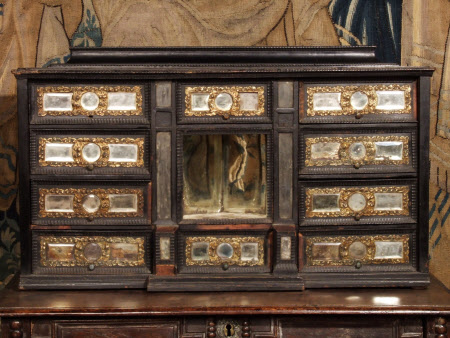Cabinet
Category
Furniture
Date
c. 1650
Materials
Copper, Ebony, Oak, Pear?, Pewter, Pine, Silvered glass, Turtleshell
Measurements
49.5 cm (h)85 cm (w)26 cm (d)
Order this imageCollection
Chastleton House, Oxfordshire
NT 1429964
Summary
An ebony-veneered and ebonised table cabinet, Italian, possibly Venice, circa 1650. With cavetto-moulded panel to the top, above an arrangement of ten drawers, all fronted with mirror plates and repoussé gilt copper ornaments, possibly once silvered. All centred by a recess mounted with mirrors and with a chequered ‘floor’, between a pair of pilasters fronted with mirrors. All within ripple mouldings. The ends each once inlaid with pewter stringing in the shape of a lozenge.
Full description
Ebonised table cabinets were made in Italy, France and the Low Countries in the 17th century. The form of this cabinet, with concave top with (once) hinged cover, and ripple mouldings, conforms closely to small table cabinets produced in Antwerp or Flanders in the 17th century, but is probably Italian, and possibly made in Venice. Although it is common for a central recess or cupboard to be lined with mirrors, it is extremely rare to find a cabinet with plain mirrors mounted on its drawer fronts, which would more commonly be decorated with inlay (either of wood or stone) or small panel paintings, retained by decorative metal mounts. Glass was used, but it was often reverse-painted using the verre eglomisé technique, as in this cabinet Cabinet | Italian, Venice (Murano) | The Metropolitan Museum of Art (metmuseum.org) in the Metropolitan Museum of Art, which incorporates Murano glass and is attributed to Venice. Cabinets were made to store, protect, and conceal natural and artificial ‘curiosities’, including fossils, plants, insects, animals, shells, coins, medals, drawings, artworks, books, and documents. Collectors at the time did not distinguish between art and science in the same way we do today. Natural and artificial curiosities were both subjects of inquiry and artifacts to cherish for their rarity and beauty. They were hoarded in cabinets or swapped for other desired items. The cabinets themselves were highly decorated and made from luxurious materials, both to reflect the importance of their contents and as objects of curiosity themselves. Other cabinets, particularly those with fall fronts, may also have been used for writing. Most were portable. Many cabinets incorporated secret or hidden drawers or compartments, for particularly special or valuable objects. How and when this cabinet came to be at Chastleton is not clear, since no cabinets are listed in the Account Book of 1738. Ebony has a long history of use by man in furniture and decorative objects, having been used by Ancient Egyptians as early as 3,000 B.C. In Early Modern Europe, it was prized for its beautiful lustre and its density – it is very hard – which allowed skilled craftsmen to carve it with intricate and detailed patterns. Its association with, in particular, French cabinet-making is enshrined in the French word for cabinet-maker – ébéniste. Ebony only grows in tropical regions, particularly Madagascar, and was first imported to Europe in the 16th century by the Portuguese. The Dutch East India Company had a monopoly on trade in ebony with Asia from 1602 until 1799. Its harvesting, and its trade, involved the labour and exploitation of enslaved peoples and significance ecological impact on the places where the ebony tree grew. The harvesting and trade in ebony are now severely restricted. Megan Wheeler, Assistant National Curator. May 2024
